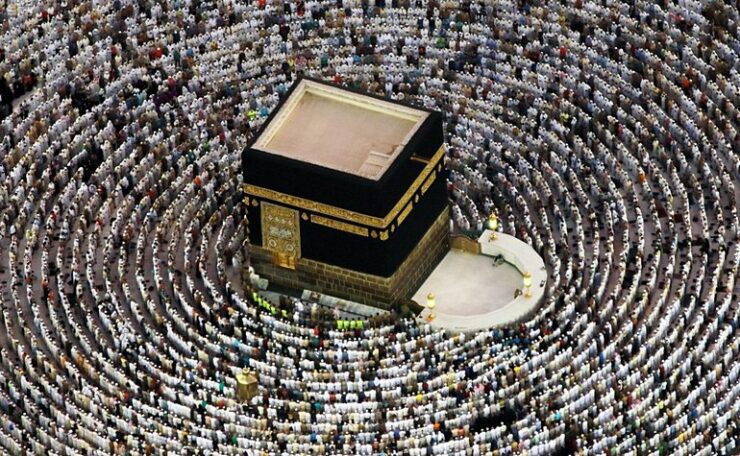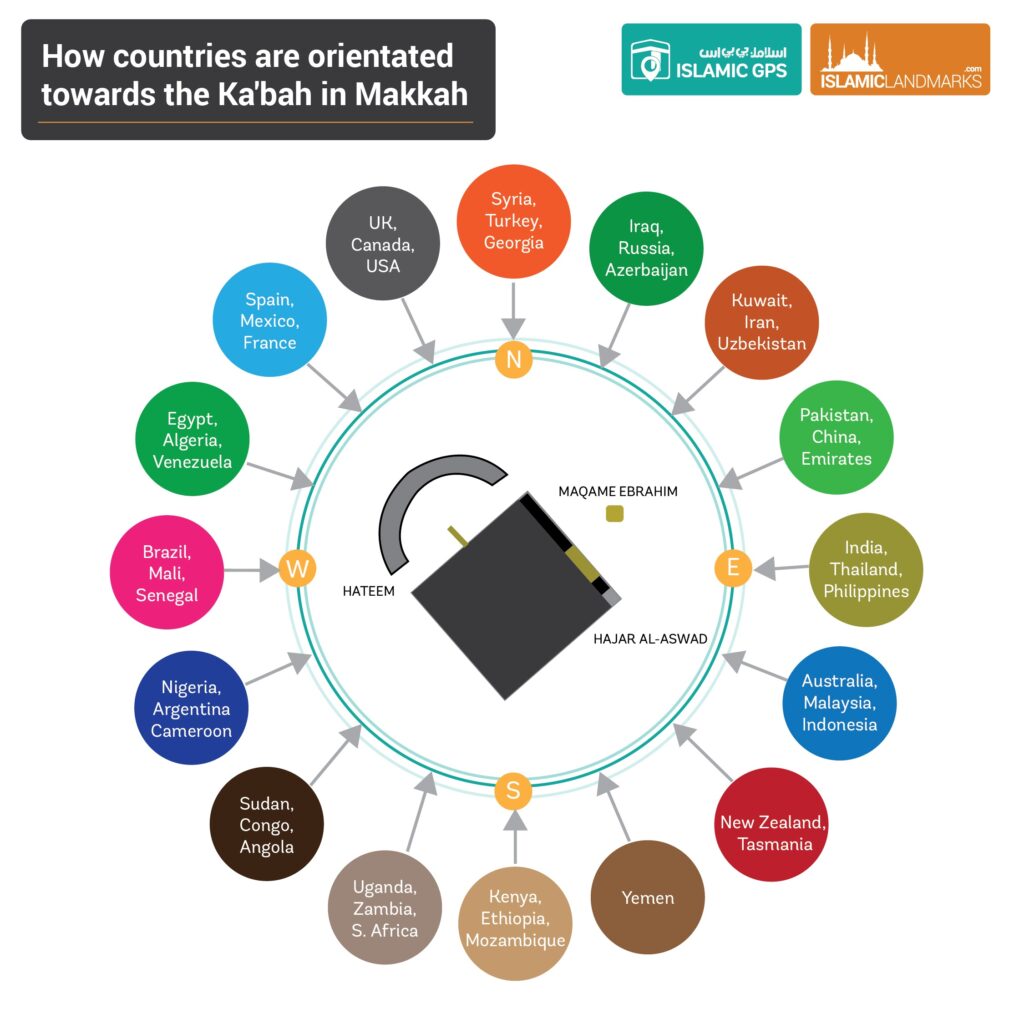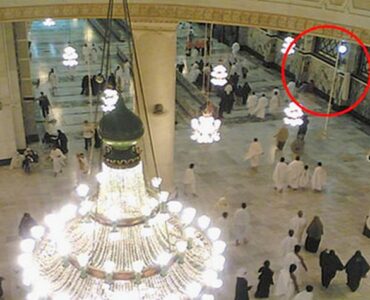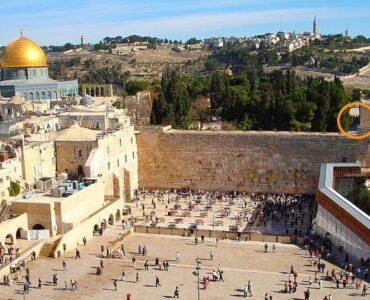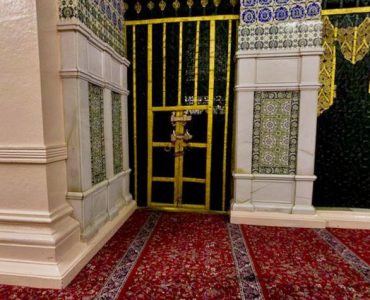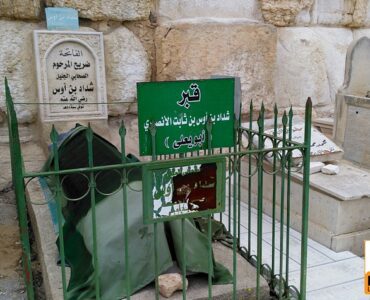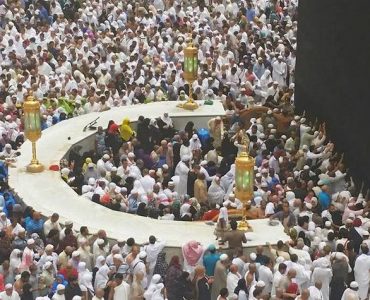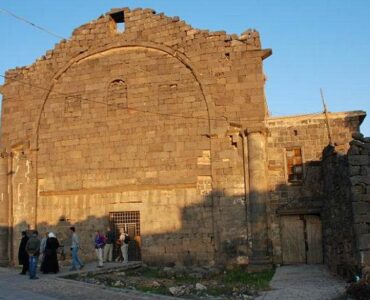The Ka’bah, also known as Baytullah (The House of Allah) is the first house built for humanity to worship Allah (ﷻ). The small, cubed building may not rival other famous buildings in terms of size but its impact on history and human beings is unmatched. It functions as the Qibla, the direction to which all Muslims pray five times a day.
Mention in the Quran
- Regarding the Ka’bah, Allah (ﷻ) mentions in the Quran in Surah Al-Ma’idah: “Allah has made the Ka’bah – the Sacred House – a means of support for people.” [5:97]
The development of the Ka’bah
- The Ka’bah has been built or adjusted on several occasions throughout history. There are differences in opinion between scholars about the builders but the general view in order is:
1. The angels
2. Prophet Adam (عليه السلام)
3. Prophet Sheeth (عليه السلام)
4. Prophet Ebrahim (عليه السلام) with his son Ismail (عليه السلام) – (c.2000 BCE)


- The original Ka’bah that was built by Adam (عليه السلام) had been destroyed by the Great Flood during the era of Nuh (عليه السلام). Almost no trace of it was left, except for a small hill that covered its foundations.
- It remained like this until the time of Ebrahim (عليه السلام). Allah (ﷻ) commanded Ebrahim (عليه السلام) to rebuild the Ka’bah along with his son Ismail (عليه السلام). They built it again on the same foundations.
- Ebrahim (عليه السلام) stood on a stone known as the Maqame Ebrahim while he was building the Ka’bah. As Ismail (عليه السلام) would pass stones to continue the build the Maqame Ebrahim miraculously continued rising higher as the walls rose. Allah (ﷻ) caused the trace of his footprints of Ebrahim (عليه السلام) to remain on the stone as a reminder to the believers among his descendants.
- The construction made by Ebrahim (عليه السلام) was rectangular in shape and did not have a roof. It had two openings at ground level, one on the easter wall, the other on the western wall. There were no actual doors, people would enter the Ka’bah, pray and then leave.
5. The Amaaliqah people
6. The Jurhum tribe
7. Qusay bin Qilab
8. The Quraysh – (605 CE)


- The Ka’bah had become eroded over time and as a result of regular flooding in Makkah, it had also sustained severe water damage.
- In addition, people would place their valuables inside as it was considered a very sacred place that nobody would dare violate. However, instances had occurred where thieves had looted the treasure that had been placed inside.
- Due to these factors, the Quraysh decided to raze the Ka’bah and do a full renovation. Even though they were staunch idol worshippers they greatly valued the sanctity of the Ka’bah and vowed to only use lawful sources of money for the construction work. However, the money ran short, resulting in an area of approximately three meters that could not be included within the walls. They demarcated this area by building the low semi-circular wall called the Hateem.
- The Quraysh raised the eastern side door high above the ground to prevent people entering at will. The door on the opposite side was sealed off. They also added a roof and a water outlet called the Meezab-e-Rahmah. The height was raised to approximately 8.64m.
9. Abdullah bin Zubair (رضي الله عنه) – (685 CE)


- During the era of Abdullah bin Zubair (رضي الله عنه) the Ka’bah was damaged by catapult fire in 64 AH when the army of Yazeed-bin-Muawiyyah laid siege to Makkah. One of Abdullah bin Zubair’s companions lit a fire, a spark flew off and set alight the kiswah (covering) of the Ka’bah. The wooden portions were burned which necessitated its demolition and reconstruction.
- Abdullah bin Zubair (رضي الله عنه) reconstructed it on the foundations of Ebrahim (عليه السلام), thus fulfilling what the Prophet (ﷺ) had wished for, as the construction made by the Quraysh was about three meters short because they had run out of lawful earnings to finance the build.
10. Hajjaj bin Yusuf – (693 CE)


- When Hajjaj-bin-Yusuf had the governership over Makkah he informed the Ummayad Khalifah Abdul Malik Ibn Marwan that Abdullah bin Zubair had changed the Ka’bah to something that was different to how it was in the lifetime of the Prophet (ﷺ). He gave permission to change it again and in 73 AH it was changed to its previous state.
- The Ka’bah reverted back to a cube shape, the Hateem was reinstated and the door on the western side was blocked again.
- However, when Abdul Malik came to know the Hadith of the Prophet (ﷺ) of how he had desired the Ka’bah to have been on the original foundations of Ebrahim (عليه السلام) he was full of remorse about what he had done.
11. Sultan Murad IV – (1630 CE)
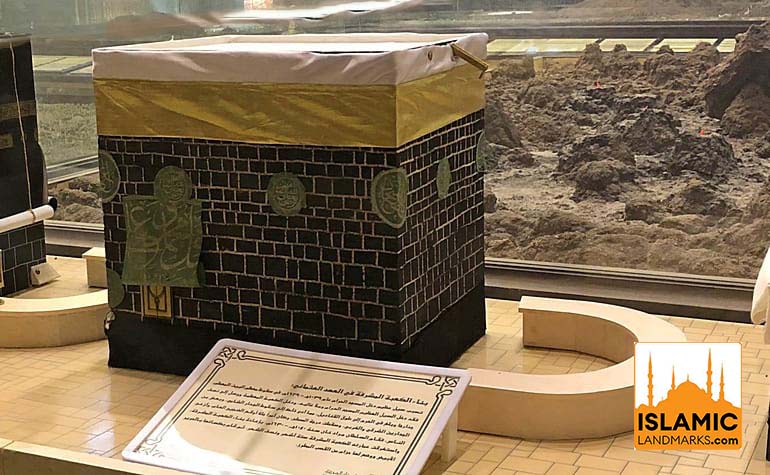

- Torrential rain fell in Makkah in Sha’ban 1039 AH resulting in heavy flooding in Masjid al-Haram to a point where the water level reached halfway up the walls of the Ka’bah. The stones had deteriorated over the centuries and the pressure of the water eventually led to the eastern and western walls to collapse.
- After the flood receded there was a clean-up operation in Masjid al-Haram and a meeting was held to discuss the rebuilding of the Ka’bah. The Ottoman ruler of the Hijaz at the time was Sultan Murad IV. and the reconstruction started under his guidance in Ramadhan that year.
- The Ka’bah was rebuilt in the same manner as had been done by the Quraysh and Hajjaj bin Yusuf. The cube shape was retained as well as the semi-circle for the Hateem. However, the height was increased to maintain its prominence among all the surrounding buildings. A plaque was displayed inside the Ka’bah in which the name of Sultan Murad and the date of the construction were inscribed.
12. King Fahd – (1995)
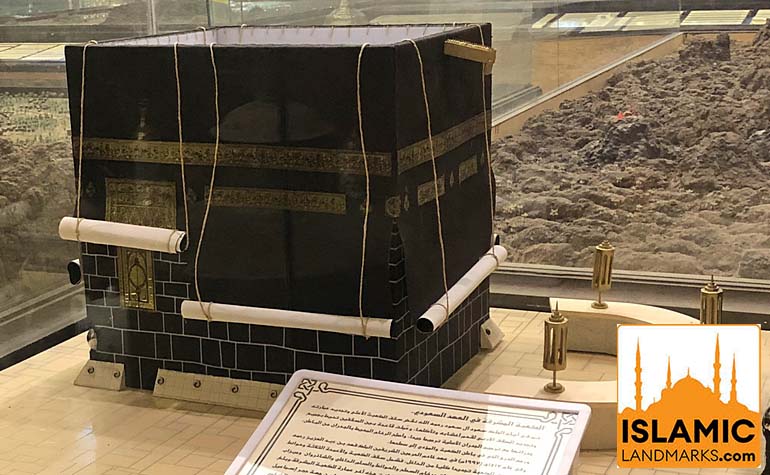

- Over the past few centuries there had been deterioration to the structure of the Ka’bah due to the effect of weather, wear and tear and the passage of time.
- This resulted in an extensive renovation during the reign of King Fahd in 1995. This has been the last major alteration of the Ka’bah.
- The external brickwork was repaired, cleaned and smoothed. Most of the work was done inside the Ka’bah. New marble was laid on the floor and walls, the three pillars from the time of Abdullah bin Zubair (رضي الله عنه) were replaced and a new green coloured cloth was laid on the walls and ceiling.
Baytul Ma’moor
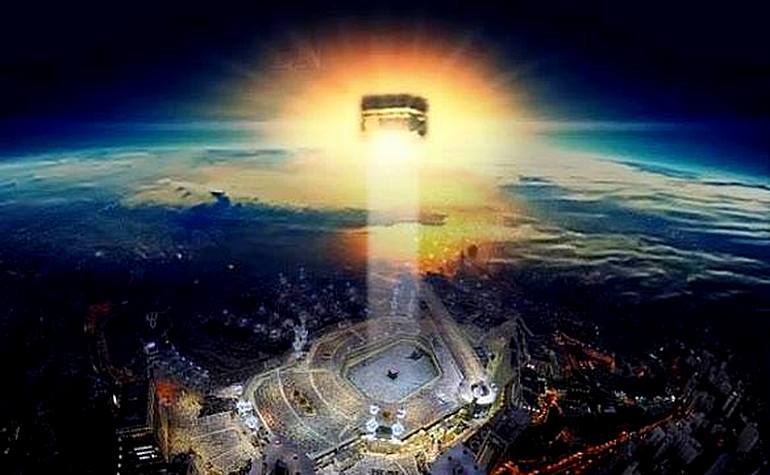

- Directly above the Ka’bah, at its zenith, there is a corresponding place in the heavens called the Baytul Ma’moor which holds the same status there as the Ka’bah does here on earth. Each day seventy thousand angels engage in worship there and none of them get a second opportunity to present themselves there again. The Baytul Ma’moor is such a sacred and honoured place that Allah (ﷻ) takes an oath on it in the Holy Quran in Surah Toor:“ And I swear by the Baytul Ma’moor. (The much visited house)” [52:4]
- During the Night of Ascension (mi’raj) when the Prophet (ﷺ) reached the seventh level of heaven, he met the Prophet Ebrahim (عليه السلام) resting against the Baytul Ma’moor. Ebrahim (عليه السلام) returned the greeting of his descendant and testified that Muhammed (ﷺ) was the Prophet of Allah.
Virtues of the Ka’bah
- Hadhrat Abdullah bin Abbas (رضي الله عنه) reports that the Prophet (ﷺ) said:“One hundred and twenty mercies descend upon the Ka’bah every day and night; sixty for those performing tawaf, forty for those engaged in salah and twenty for those who are merely looking at the Ka’bah.” [Bayhaqi]
- The noblest shade on earth is that of the Holy Ka’bah. Khabbab (رضي الله عنه) reports, “We once approached the Prophet (ﷺ) with a difficulty and found him sitting in the shade of the Ka’bah, leaning on his shawl.”
Size of the Ka’bah
- Although the Ka’bah may look like a cube, all the sides and height are of differing sizes. This image shows the sizes of each side, the height is approximately 13.1m.
Orientation of the Ka’bah
- The north corner of the Ka’bah faces towards Syria, Jordan and Palestine; the east corner (where the Hajar al-Aswad is) faces towards Oman, India and Malaysia; the south corner (Rukun Yamani) faces towards Yemen, Mauritius and Kenya; and the west corner faces towards Egypt, Morocco and Spain.
- The infographic below shows how some of the main countries around the world are approximately orientated towards the Ka’bah:
- The covering of the Ka’bah is known as the Kiswah and was first placed by the prophet Ismail (عليه السلام).
Function of the Ka’bah
- Muslims do not pray to the Ka’bah, it functions merely as a unifying direction point. During his time in Makkah, the Prophet Muhammad (ﷺ) used to pray towards Bayt-al-Maqdis (Jerusalem), with the Ka’bah in front of him.
- When he (ﷺ) migrated to Madinah, he prayed towards Jerusalem for 16 months, but he hoped it would be changed to the Ka’bah. Allah (ﷻ) then revealed the following verse in the Quran in Surah al-Baqarah: “Verily, We have seen the turning of your (Muhammad’s) face towards the heaven. Surely, We shall turn you to a Qibla (prayer direction) that shall please you, so turn your face in the direction of al-Masjid al-Haram (at Makkah). And wheresoever you people are, turn your faces (in prayer) in that direction.” [2:144 ]
The Ka’bah will be destroyed towards the end of times
- There are Ahadith that confirm that the Ka’bah will be destroyed towards the end of time. Abu Hurairah (رضي الله عنه) narrated that the Prophet (ﷺ) said: “The Ka’bah will be destroyed by Dhus-Suwaiqatain (a man with thin legs) from Abyssinia (Ethiopia).” [Bukhari]
Infographic of the Ka’bah
- Click on the image to enlarge.
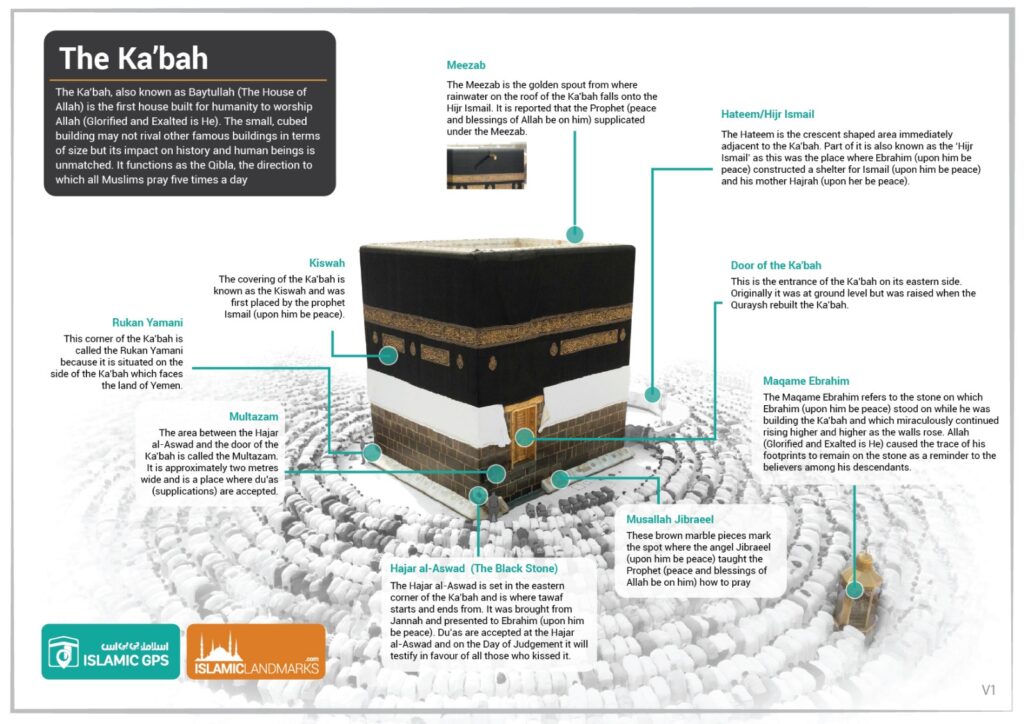

References: The History of Makkah Mukarramah– Dr Muhammad Ilyas Abdul Ghani, Holy Makkah – Shaikh Safiur-Rahman Mubarakpuri, Kabahinfo.com

